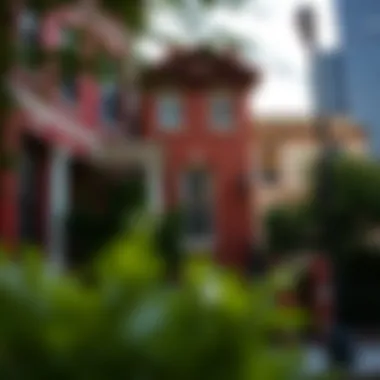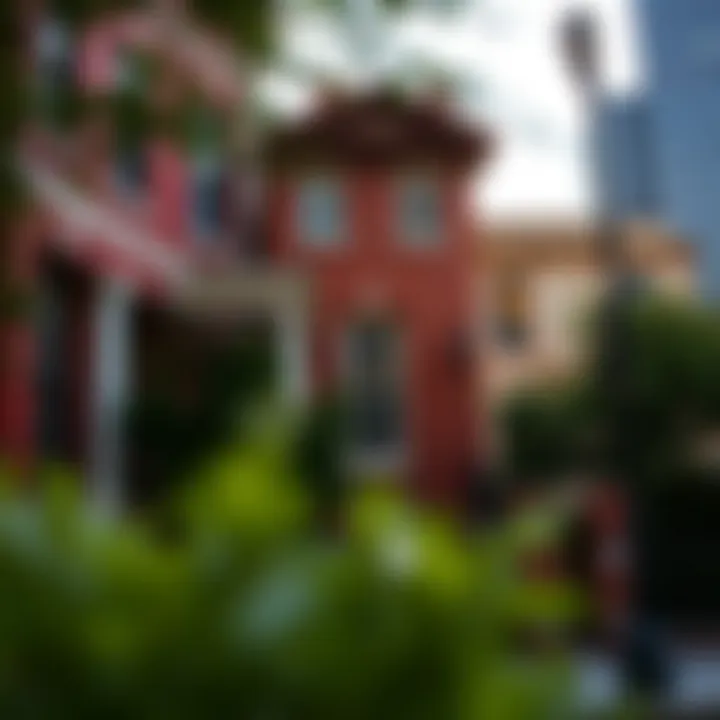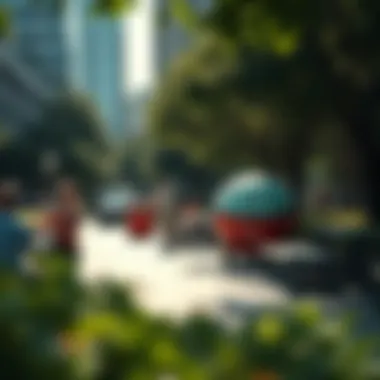Exploring Downtown Dallas Neighborhoods: A Complete Guide


Intro
Downtown Dallas buzzes with life, representing a mosaic of diverse neighborhoods, each holding its unique identity. From the shimmering skyscrapers to the charming historic buildings, downtown is a showcase of what urban living can encapsulate. This area draws in not just residents but also visitors seeking a taste of culture, commerce, and community. As we dive into the various neighborhoods within downtown Dallas, we will uncover the characteristics that make each one distinct, exploring the amenities that enhance everyday life.
Expect a closer look at the architectural gems scattered throughout the area, vibrant street life that fills the air with excitement, and the ever-evolving real estate trends that shape downtown Dallas. With the hustle and bustle, there also lies a sense of calm tucked within pocket parks and community spaces. By the end of this article, you'll have a detailed understanding of what makes downtown Dallas a compelling place to live and Visit.
Prologue to Downtown Dallas
Downtown Dallas stands as a dynamic center of culture and commerce, embodying the heart and soul of the city. Understanding this urban core is pivotal not just for potential residents and investors, but also for anyone wanting to truly appreciate the vibrancy of Dallas. Each neighborhood holds its own history, identity, and charm, making it essential to delve into this diversity when exploring the area.
Historical Context
The history of downtown Dallas is rich and layered, with origins tracing back to the mid-19th century. The area was initially a modest trading post, but as the railway network expanded, so did the prospect of growth.
A significant milestone occurred in 1873 when the Houston and Texas Central Railroad established a line through the city, transforming it into a commercial hub. The early 1900s brought about a surge in the construction of skyscrapers, which helped to redefine the skyline we see today. By the 1920s, Dallas had cemented itself as a financial stronghold, leading to the establishment of vital institutions that marked its development.
Today, remnants of its storied past coexist alongside modern architecture, offering a blend that tells the story of evolving economic tides and social changes. Black communities, for instance, have historically contributed to the fabric of downtown, particularly evident in districts like Deep Ellum, which became a flourishing center for African American musicians and artists in the early 20th century. This historical context not only adds depth to the neighborhoods but also offers insights into the cultural dynamics at play.
Geographical Overview
Geographically, downtown Dallas is strategic. Positioned within the Dallas County, it boasts direct access to major highways and is wrapped by the Trinity River, which serves as a natural landmark. The terrain consists of flatland, with the skyline punctuated by iconic structures like the Bank of America Plaza and the Renaissance Tower.
The layout is laid out in a rectangular fashion, making navigation relatively easy. Key thoroughfares such as Main Street and Elm Street serve as connective arteries, guiding residents and visitors alike through the bustling mix of office buildings, eateries, and entertainment venues.
Furthermore, the neighborhoods within downtown have distinct characteristics. For instance, the Arts District lures art aficionados with its museums and galleries, while Victory Park buzzes with sports fans and nightlife. Each area is easily accessible on foot or via public transport, ensuring that everything one might seek is just a short stroll away. This diverse geography not merely influences the way locals inhabit the space, but also shapes the tourist experience, drawing a large crowd for both leisure and commerce.
"The past and present of downtown Dallas combine to create a unique urban tapestry, reflecting the city’s continuous evolution and growth."
Ultimately, understanding the historical and geographical significance of downtown Dallas offers a lens into the everyday lives of its residents and the experiences it offers. This foundational knowledge serves as a stepping stone into the subsequent neighborhoods and real estate landscape that emphasize the distinct, vibrant character of this area.
Key Neighborhoods
The neighborhoods of downtown Dallas are the lifeblood of its urban identity. Each community offers a unique blend of culture, lifestyle, and amenities that contribute to the city's vibrancy. From the bustling Arts District to the historic streets of Deep Ellum, understanding these areas goes beyond mere geography. It's about recognizing the character and nuances that define them. Exploring these neighborhoods provides a glimpse into the various lifestyles available and the rich tapestry of experiences they have to offer, making them pivotal not just for residents but also for visitors.
The Arts District
Art Institutions
The Arts District, known for its remarkable art institutions, stands as a testament to Dallas's dedication to culture and creativity. Notable establishments like the Dallas Museum of Art and Nasher Sculpture Center serve as focal points for art enthusiasts. The district bustles with life during exhibitions and showcases, presenting artists from both local and international realms. The key characteristic of these institutions is their commitment to accessibility; they offer free general admission, making art enjoyable for all. However, the downside may be the occasional overcrowding during prominent exhibits, which can deter a more intimate experience.
Cultural Events
Cultural events breathe life into the Arts District, encapsulating the community's creativity in vibrant displays. Events such as the Dallas Arts Month transform the area into an open gallery filled with performances, shows, and interactive installations. This feature attracts both adults and families, fostering an environment of inclusivity and education. Yet, the unpredictability of weather during outdoor events can be a drawback, often leading to cancellations or delays.
Residential Life
Living in the Arts District offers a unique experience, characterized by stylish lofts and high-rise apartments that cater to those who value creativity. The distinctive architecture, combined with proximity to cultural hubs, provides a vibrant atmosphere that residents cherish. One significant aspect is the community engagement with art and performance, fostering creativity in everyday life. However, high demand and property prices can pose challenges for potential residents, particularly those starting out in their careers.
Victory Park
Entertainment Options
Victory Park is a cornerstone of entertainment within downtown Dallas. Home to the iconic American Airlines Center, the neighborhood pulsates with activity. From major sporting events to concerts, the area offers residents and visitors a cornucopia of options. A key characteristic is the varied venues available, from intimate bars to expansive amphitheaters. Nonetheless, parking and crowd management can become a hassle during peak event times, sometimes overshadowing the excitement.
Dining Scene
The dining scene in Victory Park is as diverse as the crowd it attracts. Restaurants like Gemma and Ristorante Nicola present culinary delights, ranging from upscale dining to casual bites. This variety ensures there's something for everyone. A major highlight is the waterfront views dining options offer, creating a memorable ambiance. Still, it's important to note that some establishments may have longer wait times, particularly during weekends, which could test the patience of eager diners.
Accessibility
Accessibility in Victory Park is a plus, with multiple transportation options available, including DART rail and bus services. This connectivity supports both residents commuting to work and tourists exploring the city. Furthermore, walkability is a strong suit, which enhances the overall experience, allowing for spontaneous social outings. Yet, during rush hours, congestion can be a significant issue, detracting from the efficiency of transit options.
Deep Ellum
Historical Significance
Deep Ellum's roots run deep, intertwined with the very fabric of Dallas history. Originally known as a blues and jazz hotbed in the early 20th century, the area has transformed into a bustling arts and music district. The preservation of historical buildings stands as a testament to its rich cultural heritage. A key characteristic is its ability to retain that historical essence while evolving into a modern hub. However, this evolution sometimes leads to conflicts over development and gentrification, sparking community discussions about preserving its soul.
Music and Nightlife


Deep Ellum is synonymous with music and nightlife, featuring venues like The Bomb Factory and Trees, which cater to various musical tastes. The area is known for its electric atmosphere, creating a lively scene that draws a diverse crowd. A significant appeal is live music almost every night, allowing both locals and visitors to jam out or just unwind. That said, the vibrant nightlife can lead to noise complaints from nearby residents, prompting discussions about balancing livability with excitement.
Local Art Scene
The local art scene in Deep Ellum is intrinsic to its identity. Murals and galleries dot the streets, with installations popping up frequently, showcasing both emerging and established artists. This visual art aspect not only beautifies the neighborhood but serves as an interactive experience for those passing through. Local involvement in the artistic community creates a sense of belonging for many residents. However, the inconsistency in art displays and installations may challenge visitors trying to catch specific exhibitions.
West End Historic District
Cultural Heritage
The West End Historic District is a pocket of cultural heritage, known for its rich history linked to Dallas’s early days. Landmarks such as the Sixth Floor Museum offer insights into the past, drawing in history buffs and curious travelers alike. Its preservation efforts ensure that the legacies of those who came before remain alive. A key feature is the storytelling through architecture; buildings reflect architectural styles from decades past, creating a nostalgic ambiance. Yet, balancing tourist attraction with maintaining community integrity poses continual challenges.
Shopping and Dining
The shopping and dining options in the West End provide a charming variety for both locals and tourists. Restaurants like The Dallas Fish Market and boutiques such as Café 43 create a delightful experience for shoppers and diners. This unique blend makes for a compelling stop in an already appealing neighborhood. The downside may include the lack of new retail options, as the emphasis often resides on maintaining the historic character over introducing modern brands.
Tourist Attractions
Tourist attractions in the West End offer educational and fun opportunities for exploration. From the Reunion Tower to the Perot Museum of Nature and Science, the area is filled with engaging experiences. The key characteristic of these attractions is their family-friendly nature, appealing to a broad audience. However, peak tourist seasons can lead to overcrowding, undermining the enjoyment and experience of free-roaming through the district.
Main Street District
Commercial Hub
The Main Street District acts as a commercial hub, bustling with businesses and corporate offices. The combination of cultivation of retail stores and dining venues offers significant benefits to those who work and live here. The key characteristic includes a balanced mix of promotional events, public activities, and office spaces. However, the commercial nature can suppress residential living for some, as the hustle might not align with a tranquil lifestyle preference.
Architectural Styles
The architectural styles found throughout the Main Street District highlight a blend of historic and modern designs. Examples of this can be seen in the juxtaposition of classic buildings alongside contemporary structures. This unique contrast creates an engaging skyline that reflects the evolution of Dallas. One advantage lies in its aesthetic appeal for residents, giving a sense of pride in one’s neighborhood. Conversely, maintaining these structures may be costly and challenging, as updates are often necessary while preserving historical value.
Community Events
Community events in the Main Street District foster a sense of togetherness among residents and businesses alike. Events such as the Main Street Garden gatherings and seasonal festivals promote local engagement in a fun atmosphere. The inclusive nature of these activities is a core strength, enabling residents to form lasting connections. However, its popularity sometimes leads to navigating large crowds, which may dissuade some from participating.
Real Estate Landscape
The real estate market in downtown Dallas serves as a microcosm for the city’s thriving urban life. Understanding the real estate landscape is essential, as it offers insights into economic health and future development. This section will delve into the prevailing market trends, the impact of ongoing development, and the related challenges and opportunities that residents and investors face.
Market Trends
Price Trends
Price trends in downtown Dallas are a reflection of its growing appeal as a residential and commercial hotspot. Since the last few years, properties have witnessed a steady increase in value, with several neighborhoods standing out for their exuberance.
The unique feature of price trends here is the surge in luxury condos and modern apartment complexes, which have captured the attention of young professionals and families moving to the city. A notable point to consider is that while these prices soar, affordability for low and middle-income residents tends to dwindle. Still, areas like Deep Ellum and the Main Street District offer pockets of more affordable housing, making them popular choices.
"Home prices in Dallas have been remarkably resilient, even amidst economic fluctuations."
Investment Opportunities
Investment opportunities are abundant in downtown Dallas, given the ongoing infrastructure projects and the city’s rapid growth. Developers are increasingly keen on transforming underutilized areas into vibrant communities, presenting a key characteristic of the current market.
Now, projects like mixed-use developments are becoming a magnet for investors. These setups not only promise potential returns but also foster a sense of community. However, risks such as market saturation can come into play, where too much development could mean diminishing profit margins. Hence, careful analysis of market conditions is crucial for potential investors.
Rental Market Overview
The rental market overview showcases an evolving landscape where demand frequently outpaces supply, particularly in central neighborhoods. Renters are attracted by the vibrant lifestyle and proximity to work, leisure, and culture. This aspect positions rentals as an appealing option for many newcomers.
A key factor here is the rise of short-term rentals, driven largely by platforms like Airbnb. These rentals can provide higher returns than traditional long-term leases, but they also face stricter regulations and community pushback. Being well-acquainted with these dynamics is crucial for anyone looking to navigate the rental market in downtown Dallas.
Impact of Development
New Projects
New projects within downtown Dallas highlight the area’s commitment to growth and modernization. Recent transformations around Victory Park and the Arts District point to the city’s strategy of blending historic preservation with contemporary living. These initiatives not only revitalize the neighborhood but also boost local economies and increase property values.
A unique feature is the focus on sustainability in many new developments, incorporating green spaces and environmentally-friendly designs. This aspect is attractive to both residents and investors who prioritize eco-conscious living. However, it’s important to note that development can also bring about unintended consequences for existing communities.
Gentrification Issues


Gentrification issues often surface in discussions surrounding urban development in downtown Dallas. As wealthier individuals move into historically lower-income areas, rising property values and cost of living can displace longstanding residents. This creates a complex social fabric, evolving the neighborhood's character and community dynamics.
Nonetheless, there are effective strategies that can be employed to manage this phenomenon. Community engagement and inclusive policies are central to ensuring that development occurs without erasing the cultural presence of the original residents.
Community Responses
Community responses to the transformations in downtown Dallas come in varied forms. Activism for affordable housing and preservation of cultural spaces illustrates a concerted effort by residents to maintain the authenticity of their neighborhoods. Grassroots organizations frequently collaborate with local governments to advocate for sustainable development practices that can benefit all demographics.
This landscape underscores the importance of community involvement and responsiveness to ensure that growth does not compromise the neighborhood’s integrity. Engaging local voices fosters a balanced approach to development while safeguarding the needs of all residents.
Lifestyle and Amenities
When talking about downtown Dallas, it's impossible to overlook how lifestyle and amenities shape the fabric of each neighborhood. The way folks live, eat, and play directly impacts their experience in this urban landscape. From a bustling dining scene to vibrant parks and community programs, these elements offer not just entertainment but also create a sense of belonging and identity for both residents and visitors. This section breaks down key areas highlighting what makes living in or visiting these neighborhoods a truly unique experience.
Dining and Nightlife
Culinary Diversity
Culinary diversity is a cornerstone of the dining experience in downtown Dallas. The neighborhood boasts an array of gastronomic options, from high-end eateries serving international cuisine to wholesome food trucks offering comfort food. This diversity brings together flavors and traditions from around the globe, making it a gastronomic destination. It is a popular choice because local chefs often infuse their dishes with regional ingredients and innovative techniques, making each bite an adventure.
A unique feature of this diversity lies in the fusion restaurants incorporating local Tex-Mex flavors. These establishments not only cater to the tastes of Dallas but also create a platform for culinary expression that resonates with many diners.
Popular Venues
Popular venues in downtown Dallas often serve as the heartbeat of nightlife. These places, ranging from sophisticated cocktail bars to lively dance clubs, offer myriad entertainment options for people of all ages. A key characteristic is their ability to attract a diverse crowd, from young professionals after work to couples eager for a night out.
One unique aspect of these venues is their commitment to live music. Many bars host local bands, providing an authentic experience that vibes well with patrons and enhances the nightlife culture. However, the downside is that on weekends, these venues can become quite crowded, sometimes making it challenging to enjoy the atmosphere.
Social Activities
Social activities are another vital piece of the puzzle combining lifestyle and community in downtown Dallas. From organized street fairs to seasonal festivals, these events foster connections among residents while celebrating the vibrant culture of the area. A notable feature of these activities is their inclusivity, offering something for everyone, whether it's a food festival or an art walk.
As such, these activities create a communal spirit that not only draws people together but builds lasting relationships and networks. However, they can also mean that the public spaces get quite busy, especially during large events, which can be overwhelming for some.
Parks and Recreation
Green Spaces
Green spaces in downtown Dallas are sometimes few and far between, but the ones available serve as essential retreats for both residents and visitors. These parks, such as Klyde Warren Park, not only provide a calming environment amidst the hustle and bustle of city life, but they also support various outdoor activities.
The unique feature of these green spaces is how they integrate cultural elements like art installations and public performances, enriching the park experience. They also encourage social interaction, as families and friends gather for picnics, games, or simply to enjoy nature. One downside, however, is that during peak hours, these parks can feel overcrowded.
Outdoor Activities
Outdoor activities thrive in downtown Dallas, with options ranging from yoga in the park to organized runs along scenic routes. The numerous trails and dedicated spaces for a variety of sports make it easy for people to engage with their healthy lifestyles.
A key characteristic of outdoor activities in this region is the strong community involvement. Local groups organize events encouraging participation, fostering camaraderie among participants. The downside is that weather conditions can sometimes limit these activities, particularly during the hot summer months.
Community Programs
Community programs are vital in enriching the lifestyle offerings in downtown Dallas. These initiatives often focus on promoting local arts, environmental sustainability, and public health, making them an important part of community life. A key feature of these programs is their accessibility, as many are offered at little to no cost.
These programs can be a real asset for fostering community involvement and education, bringing people together and building a sense of ownership over their neighborhood. However, it’s worth noting that not all programs may attract large participation, which can limit their impact.
Cultural Institutions
Museums
Museums in downtown Dallas play a pivotal role in shaping cultural experiences offered to both locals and tourists. The Dallas Museum of Art, for instance, showcases a rich collection spanning centuries, catering to diverse tastes. A notable characteristic of these institutions is their engagement with the community through free admission days and educational programs, making art accessible to everyone.
This unique feature allows residents to immerse themselves in culture regularly, enriching their perspectives and knowledge. However, some smaller galleries may face challenges in attracting attention due to larger competitors.
Theaters
Theaters are another cultural gem in downtown Dallas. They offer an array of performances, including theater productions, concerts, and film screenings. A key characteristic is how many theaters are located in historic buildings, adding to their charm and allure, while also preserving the city’s heritage.
The experience of these theaters often goes beyond the performance itself, with many venues hosting pre-show talks and community events, enhancing engagement between artists and audiences. On the flip side, ticket prices for popular shows can be steep, creating a barrier for some.
Public Art Initiatives


Public art initiatives add a colorful dimension to downtown Dallas, transforming ordinary street corners into vibrant showcases of creativity. Murals, sculptures, and interactive installations reflect local culture and history, making art accessible to everyone. A critical aspect of these initiatives is their ability to invite community participation in both creation and appreciation.
Unique features include art walks that celebrate local artists and cultural festivals incorporating various forms of artistic expression. However, some argue that public art projects receive variable support, influencing their sustainability.
"In downtown Dallas, lifestyle and amenities serve as a canvas on which community life is painted, bringing added richness to urban living."
Here, the elements of lifestyle and amenities work in concert to create an engaging, multifaceted experience, making downtown Dallas not just a place to live, but a thriving community to experience.
Challenges and Future Outlook
The urban landscape of downtown Dallas is experiencing a period of transition and growth, but like any vibrant city area, it is not without its challenges. Understanding these issues is crucial for current residents and future investors. This segment of the article will delve into key challenges affecting the neighborhood’s infrastructure and sustainability efforts while painting a fresh perspective on what the future may hold for downtown Dallas.
Infrastructure Needs
Public Transport
The fabric of any city is often woven through its public transport systems. In Dallas, the public transport network mainly comprises the DART rail system along with buses that connect various neighborhoods. One vital aspect of public transport is accessibility; for many residents, it serves as the lifeline that ties them to workplaces, shopping centers, and leisure activities.
While convenient, DART faces its own hurdles. A major characteristic is its relatively limited coverage in some areas, which can lead to critical delays during peak hours. Furthermore, maintaining reliability during extreme weather conditions remains a frequent issue. However, enhancement plans have been floated, aiming to expand connectivity and improve speed, which could arguably transform public transport into a much more beneficial option for commuting throughout the city.
Road Development
Roads are the veins carrying the city's lifeblood. The road development initiatives in downtown Dallas focus on reducing congestion, improving safety, and enhancing the overall travel experience for both vehicles and pedestrians. The key here is the ongoing project aimed at revitalizing main thoroughfares and optimizing traffic flow.
What's noteworthy is the integration of smart technology. With real-time traffic updates and adaptive traffic signals, roadways are becoming more efficient. However, this development comes with its challenges, such as the inconvenience caused by construction and potential pushback from residents who are concerned about the changes. It’s a double-edged sword, where progress must balance with the needs of the community.
Urban Planning Initiatives
Urban planning initiatives play a pivotal role in shaping the landscape of downtown Dallas. Sponsored by city authorities, these initiatives are geared toward creating sustainable spaces that accommodate growth while also enhancing the quality of life for residents. The community is involved in these planning efforts to some degree, allowing local insights to inform future developments.
A key characteristic of these initiatives is the focus on mixed-use developments that blend residential, commercial, and recreational spaces. This fosters community cohesion, making neighborhoods feel less fragmented. Yet, one downside is the risk of gentrification; the planning can inadvertently drive up property prices, pushing out long-term residents. This delicate balance must be managed with foresight to ensure that everyone benefits from urban evolution.
Sustainability Efforts
In a world that's increasingly leaning toward eco-friendliness, downtown Dallas is not lagging behind in sustainability efforts. As new developments rise, there's a concerted push for sustainable building practices, which is fundamental for the eco-conscious community.
Green Building Practices
Green building practices focus on reducing the environmental impact of structures, emphasizing materials that are sustainable, low-energy, and efficient in resource use. These practices are growing popular among developers due to a rising demand for eco-friendly living spaces. In essence, they promise lesser energy bills and a reduced carbon footprint, attracting buyers who are keen on sustainability.
However, the cost of implementing these standards can be high at the outset, leading some developers to hesitate. It’s a deeper investment but with the potential for long-term gains, both economically and environmentally.
Environmental Programs
Environmental programs in the downtown area aim to address various ecological issues while promoting green living. From waste reduction initiatives to city clean-up events, these programs engage residents and businesses alike in making their community healthier.
A unique feature of these programs involves collaboration between public and private entities, providing a shared sense of responsibility towards the environment. Nevertheless, continuous funding can sometimes be a hurdle, and without sustained support, these programs could wane.
Community Engagement
Engagement from residents is crucial for ensuring the sustainability efforts bear fruit. Community engagement means more than just informing the public; it involves mobilizing residents to participate in sustainability programs and planning discussions actively. This mitigates the feeling of being excluded from the decision-making table.
The advantage of this approach is twofold: it empowers residents while creating tailored solutions that address local needs. However, the downside can be a lack of interest or participation from the wider community, signaling a gap between those who care and those who don’t. Thus, fostering an engaged community remains a work in progress.
"Urban landscapes thrive when both the challenges and the opportunities are tackled with foresight and collaboration. As Dallas moves forward, the balance between growth and preserving community identity will be essential."
As downtown Dallas gears up for future challenges, understanding these intrinsic components will not only inform residents but also the wider audience interested in this dynamic urban environment.
Closure
As we wrap up this exploration into the diverse neighborhoods of downtown Dallas, it’s essential to understand the importance of the insights gleaned from this comprehensive overview. Downtown Dallas is not just a locale; it's a mixture of history, culture, and modern life. Each neighborhood, from The Arts District to Deep Ellum, contributes significantly to the pulse of the city, reflecting its uniqueness and vibrancy.
Summary of Insights
In our journey through the neighborhoods, we uncovered vital information connecting lifestyle to real estate. Each area offers distinct amenities, cultural experiences, and community vibes. Here’s a quick summary:
- The Arts District stands out with its artistic endeavors, hosting numerous galleries and theaters that shape the cultural fabric of the neighborhood.
- Victory Park provides options for entertainment and dining, making it a hub for those looking to enjoy a night out.
- Deep Ellum, known for its rich musical heritage, showcases local talents and street art, creating an atmosphere that's both dynamic and inviting.
- West End Historic District offers a glimpse into the past, featuring architecture that tells the story of Dallas’s development.
- Main Street District serves as a commercial heart, fostering business growth and community events that bring residents together.
Moreover, real estate trends reveal a growing interest in these areas, showcasing increasing property values and investment opportunities.
Final Thoughts on Downtown Dallas
The future of downtown Dallas shines bright, marked by ongoing developments and a community that is enthusiastic about enhancing its neighborhoods. As we move forward, it’s critical for residents and potential investors to remain aware of the evolving landscape. The challenges of infrastructure and sustainability efforts will shape the dialogue around what downtown Dallas will become.
Visitors and residents alike should take the time to explore beyond the surface, engaging with the various cultural offerings and local events that make each neighborhood a unique experience. The blend of old and new, tradition and modernity, continues to define this urban tapestry.
In essence, downtown Dallas isn’t just a place to live; it’s a canvas of experiences waiting to be discovered.



